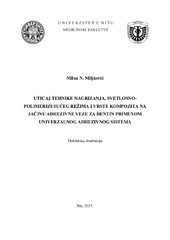| dc.contributor.advisor | Krasić, Dragan | |
| dc.contributor.other | Pešić, Zoran | |
| dc.contributor.other | Videnović, Goran | |
| dc.creator | Radović, Predrag | |
| dc.date.accessioned | 2023-10-20T20:56:59Z | |
| dc.date.available | 2023-10-20T20:56:59Z | |
| dc.date.issued | 2023 | |
| dc.identifier.uri | http://eteze.ni.ac.rs/application/showtheses?thesesId=8629 | |
| dc.identifier.uri | https://fedorani.ni.ac.rs/fedora/get/o:1921/bdef:Content/download | |
| dc.identifier.uri | https://plus.cobiss.net/cobiss/sr/sr/bib/119315209 | |
| dc.identifier.uri | https://nardus.mpn.gov.rs/handle/123456789/21798 | |
| dc.description.abstract | Fractures of the orbital walls occur relatively often as a result of violence, and traffic accidents. An isolated fracture of the orbital floor is a rare facial injury. Due to the gracile anatomical structure of the bony orbit, it is very often accompanied by a bone tissue defect. Unlike other fractures of the facial skeleton, this type of fracture deserves special clinical attention and an interdisciplinary approach to treatment.
Fractures of the orbital floor can cause ophthalmological and neurological disorders that, if not timely diagnosed and treated, can cause serious consequences for the patient, both functionally and aesthetically. Although surgically treated, orbital floor fractures are associated with the risk of developing postoperative complications such as diplopia and enophthalmos. The treatment is complex, and the patient's recovery is long and largely depends on the type of implant material used.
The bony defect of the orbital floor must be reconstructed in order to restore the previous shape and volume of the orbit, thus restoring the function of the injured orbit and its contents. Reconstruction requires the implantation of either autologous tissue or a biocompatible artificial implant that replaces the missing bone tissue. Bone autografts can be used for bone defects of the orbit. However, they require the opening of the donor site, are limited in terms of size, and complications in the donor region are also possible. In recent times, the application of non-resorbable and resorbable artificial materials that are biocompatible and used as substitutes for bone tissue is increasingly common. The advantage of implant modeling according to the shape and size of the defect, the elimination of the opening of the donor region, and satisfactory functional and aesthetic results, make these materials very suitable for the reconstruction of orbital floor defects.
It has been shown that the maxillofacial region is very suitable for the application of these implants. Application of materials based on poly d, l lactide (PDLLA) in daily clinical practice provides a great opportunity for successful treatment of blow-out fractures of the orbital floor. | en |
| dc.format | application/pdf | |
| dc.language | sr | |
| dc.publisher | Универзитет у Нишу, Медицински факултет | sr |
| dc.rights | openAccess | en |
| dc.rights.uri | https://creativecommons.org/licenses/by-nc-nd/4.0/ | |
| dc.source | Универзитет у Нишу | sr |
| dc.subject | Kliničke medicinske nauke, Maksilofacijalna hirurgija | sr |
| dc.subject | orbital fracture, orbital implants, enophthalmos, titanium mesh, resorbable implants | en |
| dc.title | Komparativna analiza tretmana preloma poda očne duplje titanijumskim i resorptivnim osteosintetskim materijalom | sr |
| dc.type | doctoralThesis | |
| dc.rights.license | BY-NC-ND | |
| dc.identifier.fulltext | http://nardus.mpn.gov.rs/bitstream/id/155747/Doctoral_thesis_14155.pdf | |
| dc.identifier.fulltext | http://nardus.mpn.gov.rs/bitstream/id/155748/Radovic_A_Predrag.pdf | |
| dc.identifier.rcub | https://hdl.handle.net/21.15107/rcub_nardus_21798 | |



